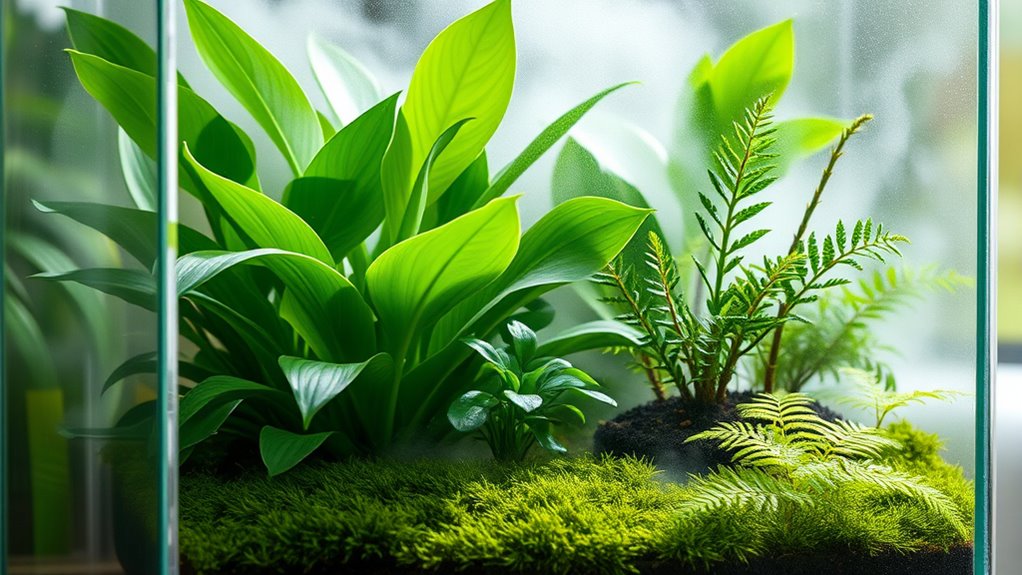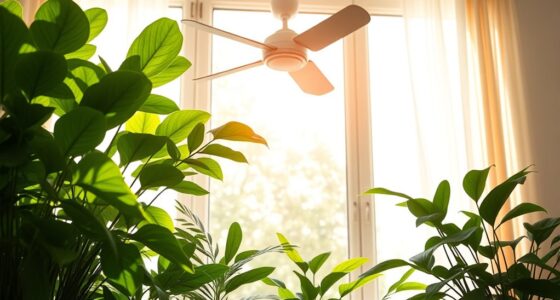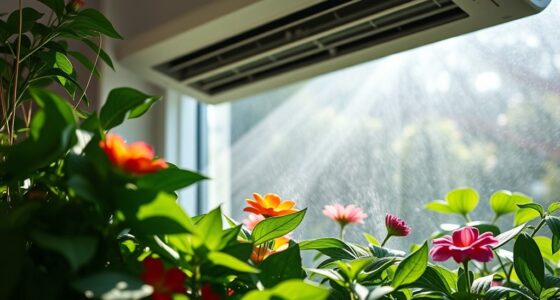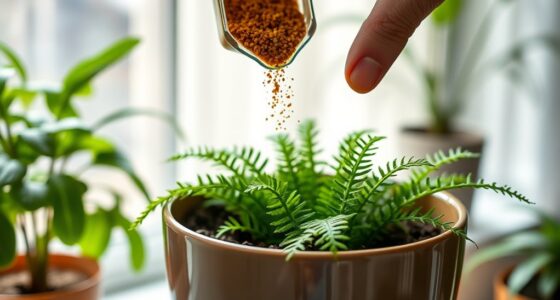To create high-humidity microclimates with grow chambers and terrariums, you should control lighting, airflow, and moisture levels carefully. Use full-spectrum LED or fluorescent lights to promote healthy growth while managing heat. Guarantee proper ventilation to prevent mold and pests, and keep conditions stable with regular monitoring. Maintaining cleanliness and good airflow helps foster a thriving environment for moisture-loving plants. If you keep these tips in mind, you’ll discover more ways to optimize your indoor jungle.
Key Takeaways
- Use sealed grow chambers or terrariums with controlled humidity levels to mimic tropical environments.
- Incorporate full-spectrum LED or fluorescent lighting to promote healthy photosynthesis and regulate microclimate conditions.
- Ensure proper airflow and ventilation to prevent excess moisture buildup, mold, and pest issues.
- Keep the environment clean and use pest screens to minimize pest intrusion and disease risk.
- Combine effective lighting, ventilation, and pest prevention to create a self-sustaining, high-humidity microclimate for indoor plants.

Grow chambers and terrariums are fundamental tools for anyone looking to cultivate plants indoors or in controlled environments. They provide the perfect space to create high-humidity microclimates, which are essential for tropical plants, orchids, and other moisture-loving species. When setting up your grow chamber or terrarium, one of your first considerations should be lighting options. Proper lighting is key because it influences plant health, growth rate, and flowering. You’ll want to choose lighting that mimics natural sunlight, such as full-spectrum LED or fluorescent lights, which offer even, adjustable illumination. These options not only promote healthy photosynthesis but also help regulate humidity levels by preventing excessive moisture buildup caused by improper lighting. Additionally, the right lighting setup reduces the risk of pests that often thrive in poorly lit, humid environments. Pests like mold, fungi, and insects tend to invade when conditions are too damp and poorly maintained, so selecting appropriate lighting helps keep these issues at bay.
You need to be mindful of how lighting interacts with humidity and airflow inside your grow chamber. Too much light can increase temperature and reduce humidity, while too little may hinder plant growth. Striking a balance is key. Many growers use timers and adjustable light fixtures to simulate day/night cycles, which not only support plant health but also minimize pest problems by maintaining consistent environmental conditions. Good lighting options also help you spot early signs of pests or disease, so you can act quickly. For example, if you notice mold growth or insect presence, adjusting lighting or airflow can help control the problem before it spreads. Maintaining proper ventilation and airflow is crucial because it helps prevent excess moisture buildup that can lead to mold and pest issues.
Beyond lighting, pest prevention is a significant aspect of maintaining a healthy high-humidity environment. Keep your chamber clean, remove dead plant material, and ensure proper ventilation to prevent mold and fungi. Using pest screens on vents and openings can keep unwanted insects out, while regularly inspecting your plants allows you to catch infestations early. Combining effective lighting choices with diligent pest prevention creates a stable environment where your plants can thrive. Properly managed, your grow chamber or terrarium becomes a self-sustaining microcosm, promoting vigorous growth and minimizing the need for chemical interventions. With the right setup, you’ll enjoy lush, healthy plants that flourish in their high-humidity microclimates, all while keeping pests under control and guaranteeing ideal lighting conditions.
Frequently Asked Questions
What Are the Best Plant Species for Grow Chambers?
When choosing the best plant species for grow chambers, focus on humidity-loving plants and tropical species. These plants thrive in high humidity environments, making them perfect for controlled microclimates. You should consider ferns, mosses, orchids, and bromeliads, as they flourish with consistent moisture. By selecting these types, you’ll create a lush, vibrant space that mimics their natural tropical habitats, ensuring healthy growth and stunning displays.
How Often Should I Water Plants Inside Terrariums?
Think of watering frequency as a gentle dance, where too much or too little can upset the rhythm. For your terrarium plants, water when the soil feels just slightly dry to the touch—usually every 1-2 weeks. Consistent humidity maintenance relies on observing your plants’ signals. Keep the environment moist but not soggy, ensuring they thrive without overwatering. Adjust your routine as you notice your plants’ responses.
Can Grow Chambers Be Used for Outdoor Gardening?
You can use grow chambers for outdoor gardening, but you’ll need to take into account outdoor integration and seasonal adjustments. They provide controlled environments, so you’ll want to adapt them to withstand weather changes and temperature fluctuations. By making these adjustments, you can extend your growing season and protect plants from harsh conditions. Just ensure the chamber’s materials are durable enough for outdoor use and regularly monitor the environment inside.
What Lighting Is Optimal for Indoor Microclimates?
Choosing the right lighting is like tuning a musical instrument—perfectly balanced. For indoor microclimates, LED spectrum is ideal because it provides specific wavelengths tailored to plant needs. You should also consider light duration; generally, 12-16 hours per day supports healthy growth. This combo guarantees your plants receive consistent, efficient light, encouraging lush foliage and vibrant blooms while conserving energy.
How Do I Prevent Mold and Pests in Humid Environments?
To prevent mold and pests in humid environments, you should focus on airflow management by ensuring good ventilation around your plants. Proper airflow reduces excess moisture, making conditions less inviting for mold and pests. Additionally, implement pest control strategies like inspecting plants regularly and removing infested foliage promptly. Keeping humidity levels balanced and avoiding stagnant air helps maintain a healthy microclimate, protecting your indoor plants from potential issues.
Conclusion
Creating grow chambers and terrariums provides the perfect high-humidity environment for your indoor plants to thrive. But remember, these microclimates aren’t just about mimicking nature—they’re about understanding that balance is key. Just like in ecosystems, too much or too little can harm your plants. Embrace these controlled environments as a way to learn patience and care, proving that sometimes, nurturing growth is about creating harmony between science and nature.










